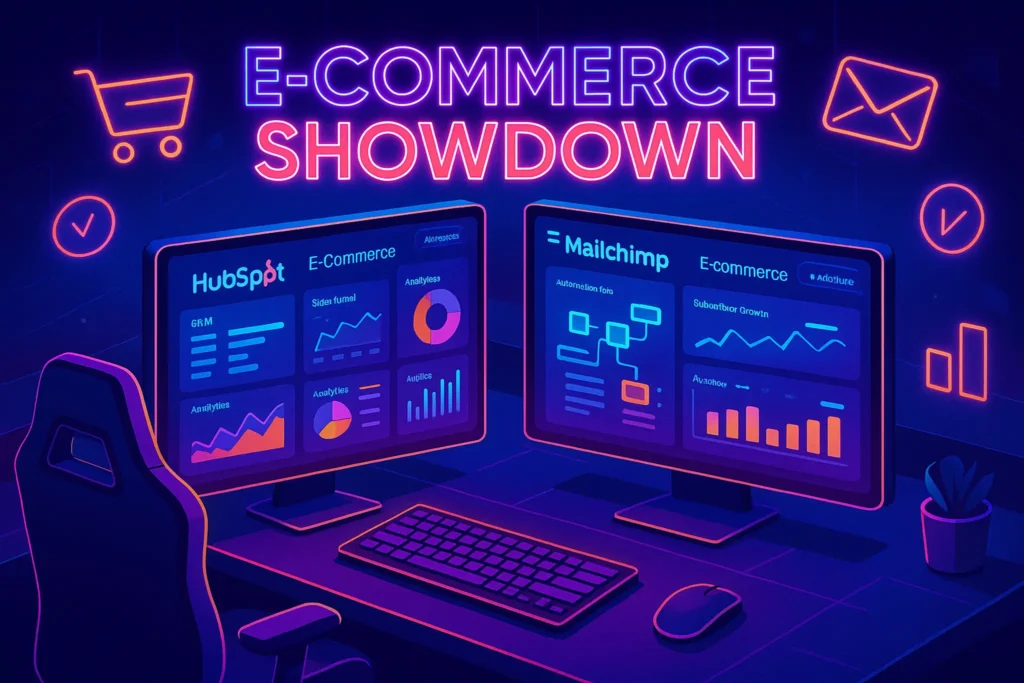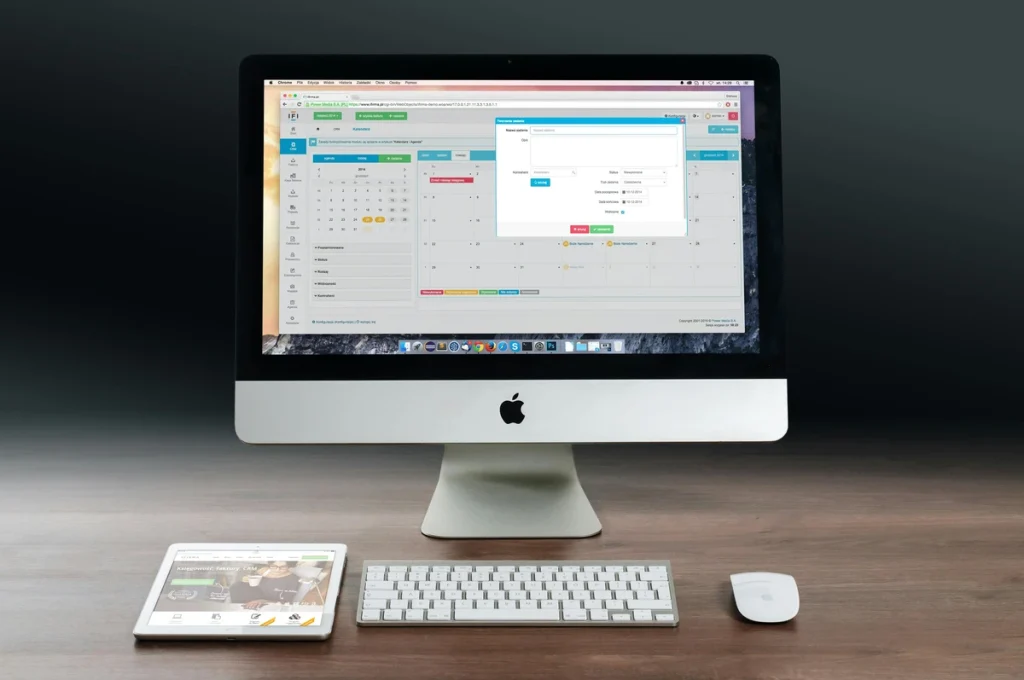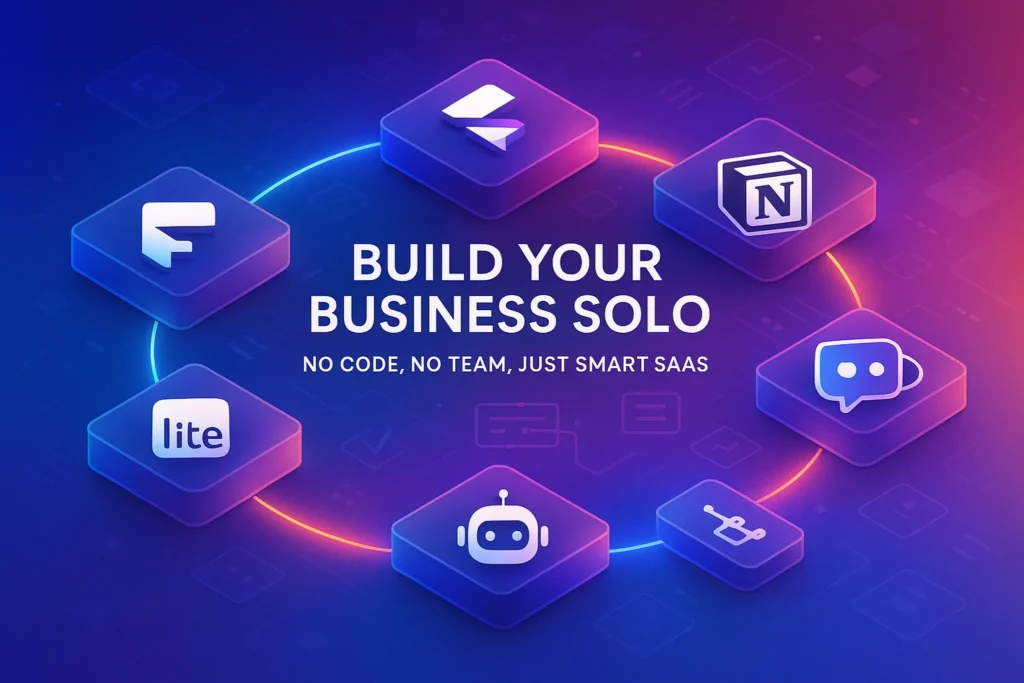Introduction:
💬 If you’re running an online store, choosing the right marketing platform isn’t just a nice-to-have — it can make or break your revenue.
HubSpot and Mailchimp are two of the most recognized names in marketing automation. Both offer email marketing, customer management, and automation workflows, but their approach to e-commerce is very different.
-
HubSpot is an all-in-one CRM and marketing suite — powerful, integrated, but often pricey.
-
Mailchimp is a specialized email marketing tool that has expanded into light CRM and e-commerce automation — affordable and beginner-friendly.
In this guide, we’ll break down features, pricing, integrations, and real-world use cases, plus run side-by-side comparisons so you know which platform is better for your online store.
📐 Keep reading — by the end of this post, you’ll know exactly which tool to invest in for your e-commerce growth.
🎯 Why This Comparison Matters for E-Commerce Owners
If you’re selling online, you need more than just email blasts. You need:
-
Automated cart abandonment sequences
-
Personalized product recommendations
-
Customer segmentation by behavior
-
Integrated sales and marketing data
-
A dashboard that gives you insights at a glance
HubSpot and Mailchimp both promise to deliver these, but the way they do it — and the cost — can be worlds apart. Choosing wrong can mean paying for features you never use or struggling with a system that can’t grow with your business.
This post isn’t just a feature checklist — it’s a decision-making guide. We’ll cover strengths, weaknesses, and the hidden factors most reviews skip.
🧠 Quick Feature Snapshot
Before we go deep, here’s the high-level difference:
| Feature Area | HubSpot | Mailchimp |
|---|---|---|
| Primary Strength | All-in-one CRM + marketing automation | Email marketing + small business automation |
| E-Commerce Tools | Advanced workflows, product recommendations, sales tracking | Cart abandonment, product recommendations |
| Ease of Use | Steeper learning curve, more customization | Beginner-friendly, quick setup |
| Integrations | Deep native integrations + API | 300+ integrations but often via middleware |
| Pricing | Can be expensive for large contact lists | Affordable, especially for small lists |
If you’re just starting to research marketing software, you may want to read our How to Choose the Right Marketing Software for Your Business guide first — it’ll help you set the right criteria before comparing specific tools like HubSpot and Mailchimp.
✅ HubSpot for E-Commerce: The All-in-One Growth Engine
When people think of HubSpot, they think of a complete marketing, sales, and service platform. For e-commerce businesses, this means it’s not just about sending emails — it’s about tracking every single customer interaction from the first website visit to repeat purchases.
💬 Why HubSpot stands out:
HubSpot integrates marketing automation with a CRM, which means your email campaigns, customer data, and sales tracking are all in one system. This makes it easier to see how marketing actually impacts revenue.
🛠 Key Features for Online Stores
-
Advanced Automation Workflows
-
Trigger emails based on browsing behavior, abandoned carts, or specific purchase history.
-
Use if/then branching to create highly personalized sequences.
-
Integrates deeply with Shopify, WooCommerce, and BigCommerce for real-time data.
-
-
CRM-Driven Personalization
-
Every contact in your database is linked to their purchase history, support tickets, and interactions.
-
Use dynamic email content — for example, recommend products based on last purchase.
-
-
E-Commerce Analytics
-
Track revenue by campaign directly in HubSpot’s dashboard.
-
See which email flows actually generate sales, not just opens.
-
-
Sales & Marketing Alignment
-
If you run B2B e-commerce, HubSpot allows your sales reps to follow up with high-value leads instantly.
-
We’ve previously covered AI-Powered Marketing and how platforms like HubSpot are starting to use AI to personalize offers in real time — a big deal for e-commerce conversion rates.
💰 Pricing for HubSpot E-Commerce Users
HubSpot’s biggest drawback is cost scaling. The Starter plan can be attractive for small lists, but as your contacts grow, pricing jumps significantly.
-
Starter CRM Suite: ~$50/month (1,000 contacts)
-
Marketing Hub Professional: ~$800/month (2,000 contacts) — this is where advanced automation and reporting kick in.
📐 If you know you’ll scale fast, calculate your 12-month cost projection now — it will make comparing HubSpot and Mailchimp much easier.
✅ Mailchimp for E-Commerce: Simplicity Meets Affordability
Mailchimp started as a straightforward email marketing service, but in recent years it has evolved into a multi-channel marketing platform — while still keeping things simple for small business owners. For e-commerce, it’s a great choice if you want quick setup, lower costs, and solid integrations without committing to an all-in-one CRM right away.
💬 Why Mailchimp works well for smaller online stores:
It has pre-built templates, a user-friendly interface, and an affordable pricing structure that doesn’t overwhelm beginners. If your focus is drip campaigns, seasonal promos, and newsletter engagement, Mailchimp delivers without steep learning curves.
🛠 Key Features for Online Stores
-
E-Commerce Store Integrations
-
Connects directly to Shopify, WooCommerce, BigCommerce, Squarespace, and more.
-
Syncs product lists, purchase data, and abandoned cart info.
-
-
Automated Email Journeys
-
Abandoned cart recovery emails that you can activate in minutes.
-
Post-purchase follow-ups for upsells and cross-sells.
-
-
Content Studio & Templates
-
Store all your brand assets — logos, colors, product photos — for consistent design.
-
Mobile-optimized templates make it easy to launch campaigns fast.
-
-
Basic CRM Capabilities
-
Tag subscribers based on interests or behavior, but it’s not as deep as HubSpot’s CRM.
-
If you’re exploring email tools beyond Mailchimp, our 10 Best Email Marketing Tools breakdown covers other affordable and powerful options worth testing.
💰 Pricing for Mailchimp E-Commerce Users
Mailchimp is generally cheaper than HubSpot — but also has limits in automation complexity.
-
Free Plan: Up to 500 contacts & 1,000 sends/month.
-
Essentials: Starts at $13/month (500 contacts).
-
Standard: $20/month — includes better automation & analytics.
📐 If you’re unsure whether you need advanced features yet, start with Mailchimp’s free plan and measure your ROI for 2–3 months before committing to premium.
📬 Want More E-Commerce Marketing Tips?
Join our free newsletter and get weekly deep-dives on marketing tools, automation hacks, and growth strategies for online stores — all in plain English, no fluff.
🔐 100% privacy. No spam. Just actionable, value-packed insights from NerdChips.
📊 HubSpot vs Mailchimp: Feature-by-Feature Comparison
To make this easier, here’s a clear comparison table for small business and e-commerce needs. This isn’t a “generic feature dump” — it’s based on actual differences that matter for online store owners deciding where to invest.
| Feature | HubSpot (Marketing Hub) | Mailchimp |
|---|---|---|
| Ease of Use | Steeper learning curve due to advanced features, but highly customizable once mastered. | Beginner-friendly, drag-and-drop interface, minimal training needed. |
| CRM Depth | Full CRM built-in with lead scoring, deal tracking, and customer lifecycle management. | Light CRM features — tagging, segmentation, basic contact profiles. |
| E-Commerce Integrations | Native Shopify & WooCommerce integration, deeper analytics on sales pipelines. | Wide range of store integrations, faster setup but less depth in analytics. |
| Automation | Complex workflows, multi-branch logic, event triggers, A/B testing. | Simple workflows, abandoned cart, post-purchase, birthday emails. |
| Analytics & Reporting | Enterprise-grade reports, attribution modeling, revenue tracking. | Basic campaign reports, A/B testing for emails, e-commerce tracking. |
| Scalability | Ideal for businesses that plan to grow into multi-channel campaigns and need advanced CRM. | Best for small to mid-sized e-commerce brands that want cost control and speed. |
| Pricing (Entry) | $45/month (Starter) with higher jumps for Pro & Enterprise tiers. | Free up to 500 contacts; Paid plans start at $13/month. |
| Best For | Stores needing full CRM + marketing automation at scale. | Stores needing fast, affordable email campaigns with good design flexibility. |
💡 Nerd Insight:
If your store is still early-stage and budget-conscious, Mailchimp’s simplicity and lower monthly cost win. But if you’re aiming for long-term growth with complex automation and deep customer insights, HubSpot is the investment that pays off in scaling.
For more software matchups like this, check out our How to Choose the Right Marketing Software for Your Business guide to see how these tools fit into a bigger marketing stack.
🧠 Choosing the Right Platform Based on Your E-Commerce Stage
Picking between HubSpot and Mailchimp isn’t about which one is “better” in a vacuum — it’s about which one fits your store’s current stage and goals. Let’s break it down:
1️⃣ Early-Stage Stores (0–500 customers)
If you’re just starting out, you likely need something:
-
Affordable to run while you test your offers.
-
Quick to set up without hiring a specialist.
-
Flexible enough to design great-looking campaigns fast.
✅ Winner: Mailchimp – Its free tier and affordable paid plans let you send welcome emails, announce sales, and do abandoned cart follow-ups without burning cash. It’s perfect for focusing on learning your customers’ behavior without overcomplicating your workflow.
Think about the time you’ll save when your email automation is actually driving revenue while you focus on product and customer experience.
2️⃣ Growth Stage (500–5,000 customers)
When your store starts generating consistent sales, your needs shift toward:
-
Better segmentation and personalization.
-
Automated customer journeys for retention.
-
Tracking customer value over time.
🔹 Recommendation: This is where either can work — Mailchimp for cost control, HubSpot for smarter automation and deeper analytics. If you can stretch your budget, HubSpot starts to shine here because its built-in CRM helps you connect marketing actions to revenue more clearly.
3️⃣ Scaling Stage (5,000+ customers)
Once you’re running multiple campaigns, selling across channels, and managing a large customer database, you’ll need:
-
Multi-step automation with conditional logic.
-
Attribution modeling to track revenue sources.
-
Advanced reporting for marketing ROI.
🚀 Winner: HubSpot – The CRM integration, sales pipeline tracking, and multi-channel automation will save you from data silos and guesswork. While the price is higher, the value in operational efficiency and lifetime customer tracking pays back fast.
Always pick a tool that matches your current needs but has a path to grow with you. Switching platforms mid-growth is a pain — and often costs more than starting with the right fit.
If you’re unsure about when to upgrade your tools, our Best Software for Managing Your Content Calendar article also shows how to align your marketing tools with your business operations so nothing falls through the cracks.
🚀 Ready to Boost Your E-Commerce Marketing?
Test-drive both platforms and see which one delivers the most sales for your store. HubSpot offers deep CRM integration, while Mailchimp keeps your costs lean. Start with free plans, then upgrade when you see measurable ROI.
🧠 Nerd Verdict
If your e-commerce business thrives on personalized customer journeys, advanced sales tracking, and all-in-one marketing + CRM integration, HubSpot delivers unmatched power — but at a premium. For brands operating on tighter budgets or just starting their online store, Mailchimp provides a lean, accessible solution with enough automation to drive meaningful sales.
The smartest approach is to choose based on where you are now and where you want to be in 12 months. Switching platforms later is possible, but selecting the right fit early saves time, migration headaches, and lost data.
💡 Nerd Tip: Many brands start with Mailchimp for cost efficiency and migrate to HubSpot when sales and subscriber volume justify the upgrade.
Already using one of these tools? Keep optimizing your deliverability by cleaning your email lists and personalizing your content.
❓ FAQ: Nerds Ask, We Answer
💬 Would You Bite?
If you had to choose today, would you go for HubSpot’s advanced all-in-one powerhouse or Mailchimp’s cost-effective simplicity?
Drop your choice below — and tell us why. 👇



